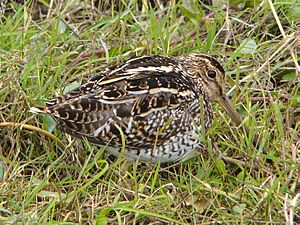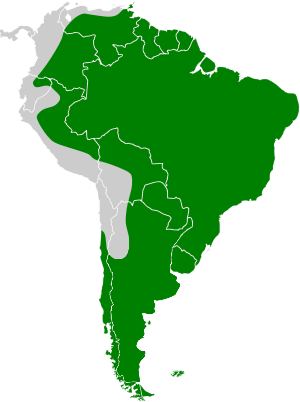Pantanal snipe facts for kids
Quick facts for kids Pantanal snipe |
|
|---|---|
 |
|
| Conservation status | |
| Scientific classification | |
 |
|
| Range of Pantanal and Magellanic snipes ("South American" snipe) |
The Pantanal snipe (Gallinago paraguaiae) is a type of bird that belongs to the sandpiper family. It lives in many parts of South America, including Trinidad and Tobago and the Falkland Islands. This bird prefers wet, grassy areas like savannas.
Contents
How Scientists Classify the Pantanal Snipe
Scientists who study birds often group them in different ways. The Pantanal snipe (G. paraguaiae) has a bit of a confusing history! In the past, it was sometimes thought to be the same as the common snipe. Other times, it was grouped with the Magellanic snipe or the puna snipe.
Today, many bird experts agree that the Pantanal snipe is its own unique species. This means it is not just a subspecies of another bird. However, some groups still consider it and the Magellanic snipe to be part of a larger "South American snipe" species. For this article, we will treat the Pantanal snipe as a separate species.
What Does the Pantanal Snipe Look Like?
The adult Pantanal snipe is about 26 to 30 cm (10 to 12 in) long. That's roughly the length of a school ruler. Males usually weigh between 105 to 140 g (3.7 to 4.9 oz). Females are a bit heavier, weighing from 115 to 185 g (4.1 to 6.5 oz).
Females are slightly larger than males. But they look very similar otherwise. They have short, greenish-gray legs. Their bill is very long, straight, and dark. Their feathers have a complex pattern. It includes muted whitish, buffy, rufous, and black colors on a brown background. Their chest and sides are buff with black marks. The rest of their belly is whitish. Their face has tan and darker brown stripes that blend together.
Where Do Pantanal Snipes Live?
The Pantanal snipe lives in almost every country in mainland South America. It is not found in Chile. It has only been seen in Ecuador a few times as a rare visitor. You can also find it on Trinidad and the Falkland Islands.
However, it is not very common in the Amazon Basin. This bird loves wet, grassy savannas. It can live at different heights above sea level. In Venezuela, it lives as high as 1,300 m (4,300 ft). In Peru, it can be found up to 2,200 m (7,200 ft). In Bolivia, it might even live as high as 2,600 m (8,500 ft).
Pantanal Snipe Behavior
How Pantanal Snipes Move Around
The Pantanal snipe generally stays in one place. It does not usually migrate long distances. However, some snipes might make short trips in winter. They do this to find marshes that stay wet all year round.
What Do Pantanal Snipes Eat?
Pantanal snipes find their food by probing in the mud with their long bills. They mainly eat small creatures without backbones, called invertebrates. Their diet includes insect larvae and earthworms. Scientists are still learning more about exactly what they eat.
Reproduction and Life Cycle
The Pantanal snipe breeds in most of South America. It avoids the Pacific coast and eastern Brazil. It also breeds on Trinidad and the Falkland Islands. The breeding season changes depending on where the birds live. It has not been fully studied everywhere.
During courtship, the male performs a special display. He flies high in circles. Then he makes shallow dives to create a unique drumming sound. This sound is made by air flowing over his outer tail feathers. A typical clutch has four eggs. We do not know much about their nests, how long the eggs take to hatch, or when the young birds leave the nest.
Sounds and Calls of the Pantanal Snipe
The Pantanal snipe makes many different sounds. It has a slow "kek..kek..kek..kek..kek..." chip call. It also has a faster "kekkekkekkekkekkekkek" chip. When it flies, it makes a "short raspy" call like "..kek......kek...kek-kek...". If it gets scared and flies away, it makes a "KEK.kek.kek.....kek.kek..." flush call. These chip calls are usually made from the ground or a low spot like a fence post.
The unique drumming sound it makes while flying is called "winnowing." Air flowing over its outer tail feathers creates this sound. It sounds like a muffled, stuttered crescendo. It might be described as "huhuhuhuhuhu.hu.WHOO..WHOO..WHOO.whu". This sound lasts about two or three seconds. The bird repeats it about every 10 seconds.
Is the Pantanal Snipe Endangered?
The IUCN (International Union for Conservation of Nature) assesses the "South American" snipe as a whole. This includes both the Pantanal and Magellanic snipes. They consider the bird to be of "Least Concern." This means it is not currently at risk of becoming endangered.
Even though its exact population size is not known, scientists believe it is stable. No immediate threats have been found that would put this bird in danger.
See also
 In Spanish: Agachadiza suramericana para niños
In Spanish: Agachadiza suramericana para niños


